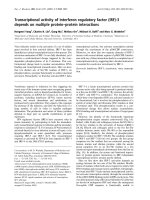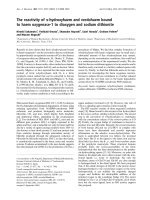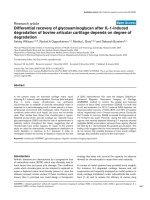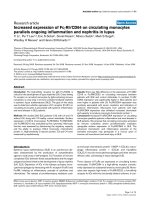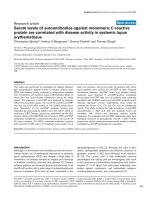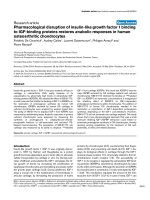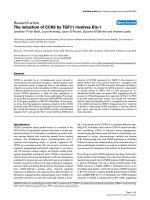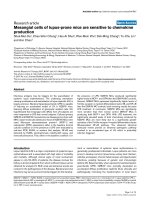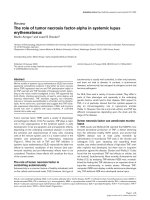Báo cáo y học: "Pharmacological disruption of insulin-like growth factor 1 binding to IGF-binding proteins restores anabolic responses in human osteoarthritic chondrocytes" ppt
Bạn đang xem bản rút gọn của tài liệu. Xem và tải ngay bản đầy đủ của tài liệu tại đây (282.77 KB, 11 trang )
Open Access
Available online />R393
Vol 6 No 5
Research article
Pharmacological disruption of insulin-like growth factor 1 binding
to IGF-binding proteins restores anabolic responses in human
osteoarthritic chondrocytes
Frédéric De Ceuninck
1
, Audrey Caliez
1
, Laurent Dassencourt
1
, Philippe Anract
2
and
Pierre Renard
3
1
Service de Rhumatologie, Institut de Recherches Servier, Suresnes, France
2
Orthopédie B, Hôpital Cochin, Paris, France
3
Service de Prospective et valorisation scientifique, Institut de Recherches Servier, Suresnes, France
Corresponding author: Frédéric De Ceuninck,
Received: 22 Mar 2004 Revisions requested: 28 Apr 2004 Revisions received: 5 May 2004 Accepted: 19 May 2004 Published: 28 Jun 2004
Arthritis Res Ther 2004, 6:R393-R403 (DOI 10.1186/ar1201)
http://arthr itis-research.com/conte nt/6/5/R393
© 2004 De Ceuninck et al.; licensee BioMed Central Ltd. This is an Open Access article: verbatim copying and redistribution of this article are per-
mitted in all media for any purpose, provided this notice is preserved along with the article's original URL.
Abstract
Insulin-like growth factor 1 (IGF-1) has poor anabolic efficacy in
cartilage in osteoarthritis (OA), partly because of its
sequestration by abnormally high levels of extracellular IGF-
binding proteins (IGFBPs). We studied the effect of NBI-31772,
a small molecule that inhibits the binding of IGF-1 to IGFBPs, on
the restoration of proteoglycan synthesis by human OA
chondrocytes. IGFBPs secreted by human OA cartilage or
cultured chondrocytes were analyzed by western ligand blot.
The ability of NBI-31772 to displace IGF-1 from IGFBPs was
measured by radiobinding assay. Anabolic responses in primary
cultured chondrocytes were assessed by measuring the
synthesis of proteoglycans in cetylpyridinium-chloride-
precipitable fractions of cell-associated and secreted
35
S-
labeled macromolecules. The penetration of NBI-31772 into
cartilage was measured by its ability to displace
125
I-labeled
IGF-1 from cartilage IGFBPs. We found that IGFBP-3 was the
major IGFBP secreted by OA cartilage explants and cultured
chondrocytes. NBI-31772 inhibited the binding of
125
I-labeled
IGF-1 to IGFBP-3 at nanomolar concentrations. It antagonized
the inhibitory effect of IGFBP-3 on IGF-1-dependent
proteoglycan synthesis by rabbit chondrocytes. The addition of
NBI-31772 to human OA chondrocytes resulted in the
restoration or potentiation of IGF-1-dependent proteoglycan
synthesis, depending on the IGF-1 concentrations. However,
NBI-31772 did not penetrate into cartilage explants. This study
shows that a new pharmacological approach that uses a small
molecule inhibiting IGF-1/IGFBP interaction could restore or
potentiate proteoglycan synthesis in OA chondrocytes, thereby
opening exciting possibilities for the treatment of OA and,
potentially, of other joint-related diseases.
Keywords: articular cartilage, IGF-1, IGFBP, osteoarthritis, pharmacological treatment
Introduction
Insulin-like growth factor 1 (IGF-1) was originally discov-
ered in 1957 by Salmon and Daughaday as a potent
growth-hormone-dependent serum factor able to stimulate
sulfate incorporation by cartilage in vitro [1]. During post-
natal, childhood, and pubertal life, IGF-1 stimulates the lin-
ear growth of bones by increasing the proliferation of
epiphyseal chondrocytes and remodeling processes within
the growth plate cartilage [2,3]. During adulthood, IGF-1
plays a crucial role in the maintenance of homeostasis in
articular cartilage, by stimulating the production of matrix
proteins by chondrocytes [4-6], counteracting their degra-
dation [6-8], and preventing cell death [9,10]. IGF-1 dis-
plays its biological effects in cartilage through the IGF-1
tyrosine kinase receptor [11], structurally related to the het-
erotetrameric insulin receptor [12]. The accessibility of
IGF-1 to its receptor is regulated by extracellular IGF-bind-
ing proteins (IGFBPs), secreted by chondrocytes but also
by the other joint tissues. Although the secretion of IGFBPs
by chondrocytes is constitutive, it is also stimulated by IGF-
1 itself. This mechanism regulates the amount of the free,
bioactive form of IGF-1 [13,14]. In case of need, IGF-1 can
BSA = bovine serum albumin; DPBS = Dulbecco's phosphate buffered saline without calcium and magnesium; dpm = disintegrations per minute;
FCS = fetal calf serum; IC
50
= median inhibitory concentration; IGF = insulin-like growth factor; IGFBP = IGF-binding protein; NP40 = Nonidet P40;
OA = osteoarthritis; rhIGF-1 = recombinant human IGF-1; SEM = standard error; TBS = Tris-buffered saline.
Arthritis Research & Therapy Vol 6 No 5 De Ceuninck et al.
R394
be released from IGFBPs. The proteolytic cleavage of
IGFBPs by various proteases dramatically decreases their
affinity for IGF-1, thereby increasing its bioavailability [15].
The action of IGF-1 in cartilage is altered during ageing and
in various pathologies such as osteoarthritis (OA), leading
to a decrease of anabolism and a detrimental increase in
catabolic events [16]. Despite the increased degradation
of cartilage in OA, the expression of IGF-1 mRNA is up-reg-
ulated in lesions of OA human cartilage [17-19], and IGF-1
protein levels rise in the synovial fluid of OA patients com-
pared to healthy subjects [20-22]. In dogs, IGF-1 levels in
a knee joint that had undergone cruciate ligament rupture
were fourfold higher than in the contralateral, unaffected
joint [23]. This increased production of IGF-1 in OA
reflected an attempt of cartilage to restore homeostasis,
but it remained inefficacious. IGF-1 receptors were present
and functional in chondrocytes from OA cartilage and thus
were not responsible for the inability of IGF-1 to trigger ana-
bolic events [19,24,25].
IGFBPs are key players in the failure of cartilage to readjust
to homeostasis during OA. Of the six known IGFBPs,
IGFBP-2, -3, and -4 are known to be secreted by articular
cartilage or chondrocytes [25-27], with IGFBP-3 being the
predominant one [28]. The expression of IGFBP-3 was 24
times as high in human OA chondrocytes as in normal
chondrocytes [18], and the amount of IGFBP-3 synthe-
sized by OA cartilage was three times that in normal carti-
lage [29]. Similarly, the amount of IGFBP-3 in OA was
three times that seen in healthy cartilage, and was positively
correlated with the severity of the disease [26]. The molar
concentration of IGFBP-3 in the synovial fluid of OA
patients was higher than that of IGF-1, leading to a molar
ratio of free to bound IGF-1 of less than 1 [21,22]. In such
conditions, no more IGF-1 should be able to reach its
receptors on cartilage. To demonstrate the involvement of
IGFBPs in IGF-1 bioactivity in vitro, Sunic and co-workers
showed that des (1–3) IGF-1, a mutant of IGF-1 lacking the
N-terminal tripeptide and with decreased affinity for
IGFBPs, stimulated the production of proteoglycans by cul-
tured chondrocytes to a higher extent than did IGF-1 [30].
Additionally, anabolic responses of chondrocytes to IGF-1
were dependent on the level of secreted IGFBPs, and the
addition of IGFBP-3 blocked the effects of IGF-1 [31].
According to the growing evidence that IGFBPs (and espe-
cially IGFBP-3) are involved in the decline of the synthesiz-
ing responses of OA cartilage, we hypothesized that these
proteins could be pharmacological targets for the treat-
ment of OA. In this study, a nonpeptide small molecule pre-
viously described as a potent inhibitor of interaction
between IGF and IGFBP [32] was used as a potential tool
to restore the anabolic response of OA chondrocytes to
IGF-1.
Materials and methods
Cells and tissues
Cartilage fragments and chondrocytes were derived from
tibial plateaus and femoral condyles of 3-week-old rabbits
or obtained after surgery for knee replacement in OA
patients (Hôpital Cochin, Paris), as described elsewhere
[33-35]. During the dissection, care was taken to avoid
bony, bloody, or fibrous pieces, and cartilage fragments
were carefully washed before the isolation of chondrocytes.
Rabbit chondrocytes were isolated from cartilage by diges-
tion in Hank's balanced salt solution (HBSS; Invitrogen,
Paisley, UK) containing 3 mg/ml of collagenase (type I;
Worthington, Lakewood, NJ, USA) and 2 mg/ml of dispase
(from Bacillus polymixa; Invitrogen). Human chondrocytes
were isolated from cartilage with similar enzyme concentra-
tions in Ham F12 medium containing 10% fetal calf serum
(FCS). Ethical guidelines for experimental investigations in
animals were followed. The experimental protocols were
used after consultation of the ethics committee of the Insti-
tut de Recherches Servier.
Materials and chemical compounds
Recombinant human IGF-1 (rhIGF-1), R
3
rhIGF-1 (an ana-
log of IGF-1 with Arg substituted for Glu at position 3), and
recombinant human IGFBP-3 (rhIGFBP-3) were from
Sigma (St Louis, MO, USA).
125
I-labeled IGF-1 and IGF-2
(specific activity 2000 Ci/mmol) were from Amersham Bio-
sciences (Buckinghampshire, UK). NBI-31772 [1-(3,4-
dihydroxybenzoyl)-3-hydroxycarbonyl-6,7-dihydroxyisoqui-
noline; C
17
H
11
NO
7
, 342.06 Da] [32] was synthesized by
Professor J-Y Laronze (University of Reims, Reims, France).
During the course of these experiments, NBI-31772 was
made available from Calbiochem (San Diego, CA, USA).
We use the term 'protease inhibitors' to refer to a commer-
cialized protease inhibitor cocktail (Complete; Roche, Mey-
lan, France) covering a broad spectrum of serine
proteases, cysteine proteases, and metalloproteases.
Radiobinding assay
The ability of NBI-31772 to displace the binding of
125
I-
labeled IGF-1 to IGFBP-3 was assessed by radiobinding
assay. Briefly,
125
I-labeled IGF-1 (12,000 disintegrations
per minute [dpm]) was incubated in 300 µl of 10 mM phos-
phate-buffered saline (PBS), pH 7.4, containing 0.02%
Nonidet P40 (NP40), with 1 ng IGFBP-3, with or without
various concentrations of IGF-1 or NBI-31772. After 3
hours at room temperature, bound
125
I-labeled IGF-1 in the
incubation mixture was separated from free material by pre-
cipitation with 1 ml of 28% polyethylene glycol (PEG 6000)
containing 0.5 mg/ml bovine gamma globulins. After 30
minutes at 4°C, the mixtures were centrifuged for 30 min at
3400 g. Supernatants were removed by aspiration and the
pellets containing
125
I-bound IGF-1 were counted in a
gamma counter. The percentage of bound material was
expressed as B/B0 where B represented binding in the
Available online />R395
presence of the competitor and B0 represented binding in
the absence of competitor (maximal binding). Typically, B0
ranged between 25 and 30% and nonspecific binding was
5%. A dose-dependent inhibition was observed with IGF-1,
with a median inhibitory concentration (IC
50
) of 0.1 nM and
the displacement curve obtained with NBI-31772 was par-
allel to that of IGF-1, with an IC
50
of 2 nM.
Western ligand blot analysis of IGFBPs
Chondrocytes were grown in Ham F12 medium containing
10% FCS, 100 IU/ml penicillin, and 100 µg/ml streptomy-
cin. Confluent cells were incubated in serum-free medium
for 24 h. This medium was discarded and cells were further
incubated in fresh, serum-free medium. Explants were dis-
sected out from cartilage, washed extensively with Dul-
becco's phosphate-buffered saline without calcium and
magnesium (DPBS, Gibco), and incubated directly in
serum-free Ham F12 medium without prior incubation in
FCS-containing medium. Secretion media from chondro-
cytes or cartilage explants were collected after 48 hours
and supplemented with protease inhibitors. Samples were
electrophoresed on laboratory-made 7.5–15% gels and
transferred onto a nitrocellulose membrane (Hybond ECL,
Amersham Biosciences) for ligand blot analysis [36]. After
two washes of 5 minutes each in 10 mM Tris-buffered
saline, pH 7.4, containing 0.15 M NaCl (TBS), membranes
were incubated for 30 minutes in TBS containing 3%
NP40 and blocked in TBS containing 0.5% (w/v) gelatin
(Bio-Rad, Hercules, CA, USA) overnight at 4°C. Mem-
branes were washed in TBS containing 0.1% Tween-20 for
10 minutes and further dried for 2 hours at room tempera-
ture. Then membranes were incubated in 20 ml of TBS
containing 0.15% gelatin plus a mixture of
125
I-labeled IGF-
1 and IGF-2 (5 × 10
5
dpm of each) for 24 hours at 4°C,
washed twice in TBS containing 0.1% Tween-20, then
three times in TBS, and dried. Gamma radiations corre-
sponding to IGFBPs were captured by autoradiography on
Biomax MS films (Eastman Kodak Co, Rochester, NY,
USA).
Measurement of proteoglycan synthesis by rabbit
chondrocytes or human OA chondrocytes
Chondrocytes grown to confluence in 24-well plates were
transferred to serum-free medium for 24 hours to discard
FCS components. In type I experiments, designed to com-
pare the effects of IGF-1 and the non-IGFBP binding
mutant of IGF-1, R
3
IGF-1, fresh serum-free medium con-
taining 0.1% BSA was added with either peptide and 1.5
µCi/ml Na[
35
SO
4
] and incubation was continued for 48
hours. In type II experiments, performed on rabbit chondro-
cytes, fresh, serum-free medium containing 0.1% BSA was
added with or without IGF-1, IGFBP-3, and NBI-31772.
After 2 hours, 1.5 µCi/ml Na[
35
SO
4
] was added in each
well and incubation was continued for 24 hours. In type III
experiments, performed on human OA chondrocytes, fresh,
serum-free medium containing 0.1% BSA with or without
IGF-1 or R
3
IGF-1 was added to the cells and they were
incubated for 24 hours. Then NBI-31772 was added with-
out renewing the medium, and 1.5 µCi/ml Na[
35
SO
4
] was
added 2 hours later. Incubation was continued for 24 more
hours. In both experiment types, the number and DNA con-
tent of cells were not modified by the treatments. The incor-
poration of [
35
S]sulfate into proteoglycans was determined
in the incubation medium and in the cell layer exactly as
described elsewhere [34]. The cell layer was treated sepa-
rately with 3 M guanidinium chloride in 50 mM Tris/HCl, pH
7.4, for 48 hours at 4°C. Aliquots of the incubation medium
or the cell layer were spotted on Whatman 3 MM paper
(Sigma, St Louis, MO, USA), precipitated with 1% cetylpy-
ridinium chloride containing 0.3 M NaCl, and dried. Scintil-
lation fluid was added and samples were counted in a beta
counter. Statistical differences between treated and con-
trol cells were assessed by Student's t-test.
Binding of
125
I-labeled IGF-1 to the surface of cultured
chondrocytes
Chondrocytes were grown in 12-well dishes in Ham F12
medium containing 10% FCS, 100 IU/ml penicillin, and
100 µg/ml streptomycin. Confluent cells were incubated in
serum-free medium for 6 hours and further incubated for 1
hour at 4°C in 500 µl of DPBS, pH 7.4, containing 0.1%
BSA and protease inhibitors, with 1 × 10
5
dpm of
125
I-
labeled IGF-1 with or without IGF-1 or NBI-31772. Previ-
ous experiments had shown that
125
I-labeled IGF-1 bound
specifically to the cell surface of chondrocytes by means of
its receptors. No significant binding to cell-surface IGFBPs
was observed. The incubation medium was harvested and
cells were washed three times with DPBS. Cells were
lysed for 15 minutes in 1 N NaOH. Radioactivities present
in supernatants, lavage media, and cells were counted to
estimate the percentage of cell-associated
125
I-labeled
IGF-1.
Competition assay of NBI-31772 with
125
I-labeled IGF-1
binding to cartilage
The methodology was adapted from that of Bhakta and co-
workers [37]. Explants were dissected out from a visually
homogeneous OA cartilage area. Cartilage explants were
minced to less than 1 mm
3
and were divided equally and
distributed in a 24-well plate at 20 explants (~2 mg) per
well in 1 ml of DPBS containing 0.1% BSA and protease
inhibitors. NBI-31772, IGF-1, or 1.5 M NaCl was dis-
pensed into wells for 24 hours at 4°C, and
125
I-labeled IGF-
1 (20,000 dpm) was added to each well for 24 more hours.
The medium was harvested and distributed into tubes, and
explants were washed three times with 1 ml of DPBS plus
0.1% BSA. Each lavage medium was also collected for
counting. The explants in each well were harvested care-
fully with a spatula and put into tubes, in 1 ml of DPBS,
0.1% BSA. Radioactivity present in medium, lavage
Arthritis Research & Therapy Vol 6 No 5 De Ceuninck et al.
R396
medium, and explants was counted. After counting,
explants were harvested, dried for 8 hours at 60°C, and
weighed. The amount of
125
I-labeled IGF-1 remaining in
cartilage was corrected for the weight. The percentage dis-
placement was calculated as 100 – [(dpm/mg in explants
in the presence of competitors) / (dpm/mg in explants in
the absence of competitors)] × 100.
Statistics
Data are expressed as means ± SEM. Statistical differ-
ences were analyzed using Student's t-test.
Results
Implication of IGFBPs in the loss of anabolic response in
OA human chondrocytes
The ability of IGF-1 to stimulate proteoglycan synthesis in
human OA chondrocytes was compared with that of R
3
IGF-1, an IGF-1 analog with a greatly reduced affinity for
IGFBPs (Fig. 1). A 48-hour stimulation time with 2.7 nM
IGF-1 was ineffective in promoting proteoglycan synthesis
by chondrocytes. By contrast, 2.7 nM R
3
IGF-1 significantly
stimulated total proteoglycan synthesis, by 45% over that
by unstimulated cells. Since IGF-1 and R
3
IGF-1 have sim-
ilar affinities for the IGF-1 receptor, the anabolic effect of
IGF peptides depended on the presence of IGFBPs in the
extracellular medium.
Identification of IGFBPs secreted by human OA cartilage
and chondrocytes
To analyze IGFBPs secreted by chondrocytes, aliquots of
the secretion medium of primary cultured chondrocytes or
cartilage explants were subjected to SDS–PAGE followed
by western ligand blotting (Fig. 2). The identity of secreted
IGFBPs was determined by running rhIGFBP-1, -2, -3, -4, -
5, and -6 in neighbouring wells during electrophoresis. Pri-
mary cultured chondrocytes secreted IGFBP-3 as the
majority IGFBP form (appearing as a characteristic doublet
at 39–42 kDa), and IGFBP-4 was also identified in all spec-
imens consistently, although more faintly. IGFBP-2 was
also found in some specimens. By contrast, IGFBP-3 was
the only IGFBP secreted by OA cartilage explants from var-
ious specimens.
Effect of NBI-31772 on proteoglycan synthesis by rabbit
articular chondrocytes
Since they respond normally to IGF-1, primary cultured rab-
bit articular chondrocytes were chosen to study the effect
of exogenous IGFBP-3 and NBI-31772 on IGF-1 stimu-
lated proteoglycan synthesis (Fig. 3). IGF-1 (1.3 nM) alone
stimulated total proteoglycan synthesis by a factor of 3.2
(Fig. 3a). The addition of a fourfold molar excess of IGFBP-
3 completely abolished the anabolic effect of IGF-1, and a
slight deleterious effect was even noticed, with proteogly-
can synthesis being 18% less than the control value. Fur-
ther addition of NBI-31772 antagonized the neutralizing
effect of IGFBP-3 on the anabolic effect of IGF-1. NBI-
31772 (1 µM) increased proteoglycan synthesis over that
measured in the presence of IGF-1 plus IGFBP-3 by 28%
(P < 0.05) and this increase reached 210% with 10 µM of
NBI-31772 (P < 0.001), corresponding to 154% over the
basal control value. NBI-31772 by itself had no effect on
Figure 1
Effect of insulin-like growth factor (IGF)-1 and R
3
IGF-1 (an analog of IGF-1 with a greatly reduced affinity for IGF-binding proteins) on total proteoglycan synthesis by human osteoarthritis chondrocytesEffect of insulin-like growth factor (IGF)-1 and R
3
IGF-1 (an analog of
IGF-1 with a greatly reduced affinity for IGF-binding proteins) on total
proteoglycan synthesis by human osteoarthritis chondrocytes. Cells
were stimulated for 48 hours with 2.7 nM IGF-1 or R
3
IGF-1 and total
proteoglycan synthesis was measured. Data are expressed as the
means and SEM of four replicates from a representative experiment
(out of three independent cultures). Statistical differences from the con-
trol were measured using Student's t-test. ***P < 0.001.
0
50
100
150
200
–
IGF-1 R
3
IGF-1
Total proteoglycan synthesis
(% of control)
***
Figure 2
Western ligand blotting analysis of insulin-like growth factor (IGF)-bind-ing proteins (IGFBPs) secreted by human osteoarthritis (OA) chondro-cytes or human OA cartilageWestern ligand blotting analysis of insulin-like growth factor (IGF)-bind-
ing proteins (IGFBPs) secreted by human osteoarthritis (OA) chondro-
cytes or human OA cartilage. Aliquots of the 48-hour secretion medium
of confluent OA chondrocytes or cartilage explants were electro-
phoresed and electroblotted onto a nitrocellulose membrane. IGFBPs
were detected by incubating the membrane with a mixture of
125
I-
labeled insulin-like growth factor (IGF)-1 and
125
I-labeled IGF-2, fol-
lowed by autoradiography. Shown are two and three representative
specimens of IGFBP-containing media from chondrocytes and cartilage
explants, respectively.
OA Cartilage
OA cells
BP-3
BP-4
BP-2
Available online />R397
proteoglycan synthesis. NBI-31772 at 10 µM significantly
stimulated the percentage of cell-associated proteogly-
cans in the presence of IGF-1 plus IGFBP-3, with a value
of 40.3% compared to a control value of 31.3% (P <
0.001) (Fig. 3b). NBI-31772 alone did not significantly
affect the ratio of cell-associated proteoglycans.
Effect of NBI-31772 on proteoglycan synthesis by human
OA chondrocytes
Depending on the concentration used, IGF-1 has no or little
effect on proteoglycan synthesis by human OA chondro-
cytes, whereas R
3
IGF-1 displays higher activity. It there-
fore seems that endogenous IGFBPs are the main
determinants of chondrocyte insensitivity to the action of
IGF-1. To further test this hypothesis, we incubated
chondrocytes for 24 hours with IGF-1 and then added NBI-
31772 to the medium and incubated them for 24 more
hours. We hypothesized that, once captured by IGFBPs
secreted in the extracellular medium, IGF-1 should be
released by addition of the small inhibitor compound and
be able to interact again with its receptor.
IGF-1 at 3.3 nM had no significant anabolic effect (an
increase of 7.8%; not statistically significant) in comparison
with the basal control, but the addition of NBI-31772 at 10
µM stimulated proteoglycan synthesis by 47% over IGF-1
alone (P < 0.001), or 58% over the basal control (Fig. 4a).
A stimulating concentration of IGF-1 (13.3 nM) led to a
52.4% increase in proteoglycan synthesis over the basal
control, and further addition of NBI-31772 at 10 µM
brought this increase to 104.2% (34% more than with IGF-
1 alone; P < 0.001) (Fig. 4b). NBI-31772 alone (added to
cells that did not receive IGF-1) had no effect on proteogly-
can synthesis. These results suggest that NBI-31772
either restored or augmented IGF-1-dependent anabolism
in human OA chondrocytes by disrupting the interaction of
the growth factor with its endogenous IGFBPs. As also
observed in rabbit articular chondrocytes, NBI-31772 at 10
µM stimulated the percentage of cell-associated proteogly-
cans compared with IGF-1 used at 3.3 nM or 13.3 nM, with
values significantly increasing from 13.5% to 15.9% of
total proteoglycans in the former case (P < 0.05), and from
13.0% to 16.0% (P < 0.001) in the latter case (Fig. 4c and
4d).
In further experiments, the stimulating effect of NBI-31772
was tested in the presence of R
3
IGF-1 by comparison with
IGF-1. Since R
3
IGF-1 does not bind to IGFBPs, we
hypothesized that NBI-31772 should not affect proteogly-
can synthesis induced by this mutant IGF-1. As expected,
NBI-31772 stimulated IGF-1-dependent proteoglycan syn-
thesis in a dose-dependent manner (Fig. 5a), but R
3
IGF-1
activity, which by itself was highly enhanced compared with
IGF-1, remained unaffected by NBI-31772 (Fig. 5b). This
experiment definitely ruled out the possibility that NBI-
31772 may act independently of its ability to inhibit the
interaction between IGF-1 and IGFBP. However, the per-
centage of cell-associated proteoglycans was significantly
increased from 13.6% to 16.5% (P < 0.001) when 10 µM
NBI-31772 was added to the medium containing R
3
IGF-1
(Fig. 5d), showing that the effect of NBI-31772 on prote-
oglycan redistribution depended on cell responses to IGF-
1 peptides, rather than to their ability to bind to IGFBPs.
NBI-31772 alone did not affect the percentage of cell-
associated proteoglycans (not shown).
Figure 3
Activity of NBI-31772, a small-molecule inhibitor of the binding of insu-lin-like growth factor (IGF)-1 to IGF-binding proteins (IGFBPs), in pri-mary cultured rabbit chondrocytesActivity of NBI-31772, a small-molecule inhibitor of the binding of insu-
lin-like growth factor (IGF)-1 to IGF-binding proteins (IGFBPs), in pri-
mary cultured rabbit chondrocytes. Chondrocytes were incubated for
24 hours with or without IGF-1, IGFBP-3, or NBI-31772, as indicated,
in the presence of 1.5 µCi/ml Na[
35
SO
4
]. Neosynthesized proteogly-
cans were measured by precipitation of nondialysable macromolecules
with cetylpyridinium chloride, both in the secretion medium and in the
cell layer, and by beta-counting. (a) Total proteoglycan synthesis and
(b) cell-associated proteoglycans, calculated as the ratio of
35
S-labeled
proteoglycans remaining in the cell layer over total proteoglycans. Data
are expressed as the means and SEM of four replicates from a repre-
sentative experiment (out of five independent cultures). Statistical differ-
ences between groups containing NBI-31772 plus IGF-1 plus IGFBP-
3 and the control group (IGF-1 plus IGFBP-3) were measured by Stu-
dent's t-test. *P < 0.05; ***P < 0.001.
Total proteoglycan synthesis
(% of control )
0
IGF- 1 (1.3 nM)
IGFBP-3(5.3nM)
NBI-31772 (µM)
Cell-associated proteoglycans
(% of control )
–
+
+
–
–
–
–
–
+
0.1
+
+
1
+
+
10
+
+
10
-
-
20
30
10
40
50
0
***
***
*
300
200
100
(a)
(b)
Arthritis Research & Therapy Vol 6 No 5 De Ceuninck et al.
R398
Effect of NBI-31772 on
125
I-labeled IGF-1 binding to
human OA chondrocytes
To ensure that NBI-31772 did not affect the binding of IGF-
1 to its receptors, it was used as a potential competitor in
a cell-binding assay on human OA chondrocytes (Fig. 6).
125
I-labeled IGF-1 bound specifically to confluent chondro-
cytes, since 84% of the radioactivity could be released by
the addition of excess unlabeled IGF-1. When added at the
highest dose used in biological assays (10 µM), NBI-
31772 did not displace specific
125
I-labeled IGF-1 binding
from the cell surface.
Competition assay of NBI-31772 with
125
I-labeled IGF-1
for binding to cartilage
This experiment was set up to determine whether NBI-
31772 would displace
125
I-labeled IGF-1 from its IGFBPs
within cartilage. To ensure maximal homogeneity, 20
explants coming from a restricted area of a single cartilage
specimen were selected for each well. Cartilage explants
previously incubated with potential competitors or not were
further incubated with 20,000 dpm
125
I-labeled IGF-1. The
amount of
125
I-labeled IGF-1 remaining in cartilage in the
presence of 11.7 nM IGF-1 was 53% of the control value,
demonstrating that only 47% of the radiolabeled peptide
was bound specifically to proteins within cartilage (Fig. 7).
No further displacement was observed with higher IGF-1
concentrations (not shown). About 43% of the cartilage-
associated radioactivity was removed with 1.5 M NaCl,
showing that nearly half of the
125
I-labeled IGF-1 was
bound in a nonspecific manner to cartilage through ionic
interactions, possibly to proteoglycans. By contrast with
IGF-1, R
3
IGF-1 did not compete with
125
I-labeled IGF-1,
demonstrating that IGF-1 was primarily bound to IGFBPs
within cartilage. NBI-31772 (10 µM) did not compete with
125
I-labeled IGF-1 binding to cartilage IGFBPs, suggesting
that it did not penetrate into cartilage.
Discussion
The loss of anabolic responses of chondrocytes to IGF-1 is
one of the reasons why diseased cartilage cannot counter-
act the action of catabolic cytokines during OA. The results
of the present study show that NBI-31772, a small, non-
peptide compound that binds to endogenous IGFBPs and
releases biologically active IGF-1 [32], can restore prote-
oglycan synthesis by human OA chondrocytes, therefore
opening the possibility of a new field of pharmacological
intervention for the treatment of OA and other joint-related
diseases.
As previously demonstrated in ovine and bovine chondro-
cytes [30], a mutant of IGF-1 with strongly decreased affin-
ity for IGFBPs was able to stimulate the synthesis of
Figure 4
Effect of NBI-31772, a small-molecule inhibitor of the binding of insulin-like growth factor (IGF)-1 to IGF-binding proteins (IGFBPs), in primary cul-tured human osteoarthritic chondrocytes incubated with IGF-1Effect of NBI-31772, a small-molecule inhibitor of the binding of insulin-like growth factor (IGF)-1 to IGF-binding proteins (IGFBPs), in primary cul-
tured human osteoarthritic chondrocytes incubated with IGF-1. Chondrocytes were incubated with (a,c) 3.3 nM or (b,d) 13.3 nM IGF-1 for 24
hours; NBI-31772 (0.1–10 µM) was added and the cells were incubated for 24 more hours, in the presence of 1.5 µCi/ml Na[
35
SO
4
]. (a,b) Total
proteoglycan synthesis and (c,d) cell-associated proteoglycans calculated by the ratio of
35
S-labeled proteoglycans remaining in the cell layer over
total proteoglycans. Data are expressed as the means and SEM of four replicates from a representative experiment (out of four independent cul-
tures). Statistical differences between groups containing NBI-31772 plus IGF-1 and the respective control group (IGF-1 at 3.3 nM or 13.3 nM) were
measured by Student's t-test. *P < 0.05; ***P < 0.001.
IGF-1(nM)
NBI-31772 (µM)
–
–
–
3.3
0.1
3.3
1
3.3
10
3.3
–
–
–
13.3
0.1
13.3
1
13.3
10
13.3
Total proteoglycan synthesis
(% of control )
Cell-associated proteoglycans
(% of control )
0
10
20
0
10
20
0
50
100
150
200
250
0
50
100
150
200
250
***
***
*
***
*
(a) (b)
(d)(c)
Available online />R399
proteoglycans by OA chondrocytes to a higher extent than
did IGF-1. This simple but convincing experiment was the
basis for suspecting the involvement of endogenous
IGFBPs in the loss of IGF-1 effects in OA chondrocytes,
and it was a prerequisite to justify their targeting. Three
forms of IGFBPs were found to be secreted by human OA
chondrocytes, the major one being IGFBP-3. OA cartilage
explants secreted IGFBP-3 exclusively. In a functional radi-
obinding assay, NBI-31772 displaced the binding of
125
I-
labeled IGF-1 at a molar concentration 20 times that of
unlabeled IGF-1. Although the ability of NBI-31772 to dis-
place
125
I-labeled IGF-1 from the other IGFBPs has not
been checked in this study, it has been previously shown
that it can interact with all six IGFBPs with similar efficacy
[32]. Therefore, it is probable that in the experiments with
OA chondrocytes, NBI-31772 also acted by displacing
IGF-1 from IGFBP-2 and -4 in addition to IGFBP-3.
In the first set of experiments with rabbit chondrocytes,
IGFBP-3 at a concentration four times that of IGF-1
completely abolished the stimulation of proteoglycan syn-
thesis by IGF-1, and NBI-31772 partially restored IGF-1-
dependent synthetic activities at 1 µM and almost totally at
10 µM. These concentrations were much higher than those
found to displace
125
I-labeled IGF-1 from IGFBP-3 in the
radiobinding assay. This discrepancy was also found in a
previous study reporting the activity of NBI-31772 on the
reversal of IGFBP-3 inhibition of Balb/c3T3 IGF-1-depend-
ent proliferation [38]. The higher amounts of IGFBP-3 used
in the biological assays compared with the radiobinding
assay may in part account for this discrepancy. On the
other hand, differences may rest on a decreased stability of
the chemical compound in a biological environment and/or
to its capture or neutralization by chondrocyte-secreted
proteins or macromolecules, thus limiting its activity. Similar
results were found for human OA chondrocytes, without
addition of IGFBP-3. In this cellular model, we asked
whether NBI-31772 could displace IGF-1 from endog-
enous IGFBPs. As also found by others [27,29,39], IGF-1
was either not detectable or poorly detectable in the extra-
cellular medium, reflecting poor ability of chondrocytes to
secrete IGF-1. Thus, it was given exogenously. The addition
of NBI-31772 was able to activate or increase proteogly-
can synthesis, showing that complexes of IGF-1 with
IGFBP could be disrupted to release bioactive IGF-1. NBI-
31772 also significantly increased the ratio of cell-associ-
ated proteoglycans in the presence of IGF-1/IGFBP com-
plexes. When, in these experiments, IGF-1 was replaced by
R
3
IGF-1, the stimulating effect of NBI-31772 on proteogly-
can synthesis was completely abolished, thus ruling out the
possibility that NBI-31772 may act independently of the
inhibition of IGF-1-binding to IGFBPs. However, an
Figure 5
Comparative activity of NBI-31772, a small-molecule inhibitor of the binding of insulin-like growth factor (IGF)-1 to IGF-binding proteins (IGFBPs), in primary cultured human osteoarthritic chondrocytes incubated with IGF-1 or R
3
IGF-1 (an analog of IGF-1 with a greatly reduced affinity for IGFBPs)Comparative activity of NBI-31772, a small-molecule inhibitor of the binding of insulin-like growth factor (IGF)-1 to IGF-binding proteins (IGFBPs), in
primary cultured human osteoarthritic chondrocytes incubated with IGF-1 or R
3
IGF-1 (an analog of IGF-1 with a greatly reduced affinity for IGFBPs).
Chondrocytes were incubated with (a,c) 3.3 nM IGF-1 or (b,d) 3.3 nM R
3
IGF-1 for 24 hours; NBI-31772 (0.1–10 µM) was added and the cells
were incubated for 24 more hours in the presence of 1.5 µCi/ml Na[
35
SO
4
]. (a,b) Total proteoglycan synthesis and (c,d) cell-associated proteogly-
cans, calculated from the ratio of
35
S-labeled proteoglycans remaining in the cell layer over total proteoglycans. Data are expressed as the means
and SEM of four replicates from a representative experiment (out of four independent cultures). Statistical differences between groups containing
NBI-31772 plus IGF-1 or R
3
IGF-1 and the respective control groups (IGF-1 or R
3
IGF-1) were measured using Student's t-test. *P < 0.05; ***P <
0.001.
Total proteoglycan synthesis
(% of control )
Cell-associated proteoglycans
(% of control )
0
10
20
0
10
20
0
50
100
150
200
0
50
100
150
200
*
***
3.3
peptide (nM)
NBI-31772 (µM)
3.3 3.3 3.3
–
––
0.1 1 10
3.3 3.3 3.3 3.3
–
––
0.1 1 10
250 250
(a) (b)
(d)(c)
***
*
Arthritis Research & Therapy Vol 6 No 5 De Ceuninck et al.
R400
increase of cell-associated proteoglycans was still
observed, showing that this effect of NBI-31772 occurred
apart from IGFBPs. Although unexplained, this mechanism
may be important in a pathological context, since commu-
nication between chondrocytes and the extracellular matrix
is disrupted in OA, and an increase of pericellular prote-
oglycans may help to maintain chondrocytes in a more favo-
rable environment.
Under physiological conditions, IGF-1/IGFBP complexes
can be disrupted by various proteases [15], thereby
releasing active IGF-1. In a recent report by Fowlkes and
co-workers, matrix metalloproteinase 3 was able to disrupt
IGF/IGFBP-3 complexes and to liberate free, intact IGFs
able to phosphorylate the IGF-1 receptor and to trigger cell
proliferation [40]. A few different approaches have been
used to prevent excessive sequestration of IGF-1 and
restore its bioavailabity in pathological conditions. Mutant
peptides of IGF-1 still able to bind to IGFBPs but with very
weak affinity for the IGF-1 receptor were designed to dis-
place native IGF-1 from endogenous IGFBPs [41-45].
Phage-displayed peptide libraries yielded small peptide
compounds able to selectively displace IGF-1 from IGFBP-
1 or IGFBP-3 [45,46]. From the last generation, low-molec-
ular-weight compounds (fluorenylmethoxycarbonyl deriva-
tives) were shown to bind to the IGF-1 binding site on
IGFBP-5 [47], and small isoquinoline compounds were
shown to displace IGFs from IGFBPs without selectivity for
a particular IGFBP [32,38,44,48,49]. These molecules
have been proposed as potential drug candidates for the
treatment of diabetes [32,45], renal disease [50], or neuro-
degenerative diseases [43,44].
Most of the current pharmacological approaches for the
treatment of OA aim to prevent catabolism by blocking
actors of the deleterious cascade, while restoration of
anabolism or cartilage regeneration still rests on invasive
procedures [51]. In this context, in situ cartilage
Figure 6
Effect of NBI-31772, a small-molecule inhibitor of the binding of insulin-like growth factor (IGF)-1 to IGF-binding proteins, on
125
I-labeled IGF-1 binding to human osteoarthritic chondrocytesEffect of NBI-31772, a small-molecule inhibitor of the binding of insulin-
like growth factor (IGF)-1 to IGF-binding proteins, on
125
I-labeled IGF-1
binding to human osteoarthritic chondrocytes. Confluent chondrocytes
were incubated with 1 × 10
5
dpm
125
I-labeled IGF-1 with or without
excess (150 nM) IGF-1 or 10 µM NBI-31772 for 1 hour at 4°C.
Medium was harvested and cells were washed three times with Dul-
becco's phosphate-buffered saline. Cells were lysed in 1 N NaOH. The
percentage of
125
I-labeled IGF-1 bound to the cells was calculated as
dpm in NaOH-treated cells over total dpm. Data are expressed as the
means and SEM of four replicates from a representative experiment
(out of two independent cultures).
0
5
10
15
125
I-IGF-1 binding (%)
IGF-1 NBI-31772
–
Figure 7
Competition of NBI-31772, a small-molecule inhibitor of the binding of insulin-like growth factor (IGF)-1 to IGF-binding proteins (IGFBPs), with
125
I-labeled IGF-1 binding to cartilageCompetition of NBI-31772, a small-molecule inhibitor of the binding of insulin-like growth factor (IGF)-1 to IGF-binding proteins (IGFBPs), with
125
I-
labeled IGF-1 binding to cartilage. Explants cut from a homogeneous area of osteoarthritic cartilage were separated in equal groups and incubated
with 11.7 nM R
3
IGF-1 (an analog of IGF-1 with a greatly reduced affinity for IGFBPs), 11.7 nM IGF-1, 1.5 M NaCl or 10 µM NBI-31772 in 1 ml of
Dulbecco's phosphate-buffered saline (DPBS) for 24 hours at 4°C.
125
I-labeled IGF-1 (20,000 dpm) was added to each incubation medium and the
cells were incubated for 24 more hours. The medium was harvested and explants were washed three times with DPBS. The radioactivity in medium,
lavage buffer, and cartilage explants was counted. The percentage of
125
I-labeled IGF-1 remaining in cartilage was corrected for the weight of
explants and divided by total counts. Data are the means of two experiments. Results are expressed as percentages of the control value (cartilage
incubated with
125
I-labeled IGF-1 alone).
0
20
40
60
80
100
120
125
I-labeled IGF-1/mg explant
(% of control)
R
3
IGF-1 IGF-1 N aCl
NB I-31772
Available online />R401
regeneration by growth-factor therapy, including targeting
of cartilage defects with fibrin–(chondrocyte)–IGF-1 com-
posites [52,53], or gene therapy with IGF-1 delivered intra-
articularly [54-56], have been proposed. To be effective,
the amount of IGF-1 delivered within the joint in this way
should exceed the binding capacity of local IGFBPs. In
addition to noninvasive intervention, one of the main advan-
tages of our proposed strategy would be to target directly
the actors of cartilage unresponsiveness to IGF-1, and to
bypass the capture of exogenous IGF-1 by IGFBPs. Keep-
ing this objective in mind, it is clear that the small com-
pound used in this study, NBI-31772, should be
considered only a tool to demonstrate the concept in vitro.
Indeed, concentrations of NBI-31772 active in the biologi-
cal assays were relatively high (1–10 µM) and would be
incompatible with in vivo trials. Secondly, NBI-31772 did
not penetrate into cartilage. This should not be an exclusion
criterion per se, since one may hypothesize that if the com-
pound were capable of reaching the synovial fluid or carti-
lage surrounding tissues, it might release IGF-1 captured
by IGFBPs in these tissues and sustain its action in carti-
lage. However, the in vivo duration of action of NBI-31772
was short [48], which implies that in vivo trials to assess
the therapeutic relevance of this class of molecule in joint
diseases need to be performed with more stable mole-
cules. In view of a therapeutic application, the optimization
of small chemical inhibitors of IGF/IGFBP interaction would
be preferred over the use of IGF-1 peptide mutants (either
binding receptors and triggering biological effects without
binding IGFBPs, or, conversely, displacing endogenous
IGF-1 from IGFBPs without binding receptors), since the
former should be more easily optimizable while the latter
should be more susceptible to the attack by proteases. In a
clinical context, compounds that selectively target IGFBP-
3 would be mandatory if oral availability is preferred, in
order to avoid or to limit side effects caused by displacing
IGF-1 from its binding proteins in undesirable tissues. This
question of selectivity may not be so important in the case
of topical delivery, and local treatment should be envisaged
instead.
Conclusion
A small, nonpeptide pharmacological inhibitor of IGF/
IGFBP interaction restored or enhanced the IGF-1-
dependent proteoglycan synthesis by human osteoarthritic
chondrocytes. This finding offers a rationale for pharmaco-
logical intervention in the treatment of cartilage repair in
osteoarthritis and potentially of other joint-related diseases
and shows that IGFBPs are pertinent target candidates for
this purpose.
Competing interests
None declared.
Acknowledgements
We thank Prof J-Y Laronze for chemical synthesis of NBI-31772.
References
1. Salmon WD, Daughaday WH: A hormonally controlled serum
factor which stimulates sulphate incorporation by cartilage in
vitro. J Lab Clin Med 1957, 49:825-836.
2. Schoenle E, Zapf J, Hauri C, Steiner T, Froesch ER: Comparison
of in vivo effects of insulin-like growth factors I and II and of
growth hormone in hypophysectomized rats. Acta Endocrinol
1985, 108:167-174.
3. Russell SM, Spencer EM: Local injections of human or rat
growth hormone or of purified human somatomedin-C stimu-
late unilateral tibial epiphyseal growth in hypophysectomized
rats. Endocrinology 1985, 116:2563-2567.
4. McQuillan DJ, Handley CJ, Campbell MA, Bolis S, Milway VE, Her-
ington AC: Stimulation of proteoglycan synthesis by serum
and insulin-like growth factor-I in cultured bovine articular
cartilage. Biochem J 1986, 240:423-430.
5. Trippel SB, Corvol MT, Dumontier MF, Rappaport R, Hung HH,
Mankin HJ: Effect of somatomedin-C/insulin-like growth factor
I and growth hormone on cultured growth plate and articular
chondrocytes. Pediatr Res 1989, 25:76-82.
6. Luyten FP, Hascall VC, Nissley SP, Morales TI, Reddi AH: Insulin-
like growth factors maintain steady-state metabolism in
bovine articular cartilage explants. Arch Biochem Biophys
1988, 267:416-425.
7. Berenbaum F, Thomas G, Poiraudeau S, Bereziat G, Corvol MT,
Masliah J: Insulin-like growth factors counteract the effect of
interleukin 1 beta on type II phospholipase A2 expression and
arachidonic acid release by rabbit articular chondrocytes.
FEBS Lett 1994, 340:51-55.
8. Hui W, Rowan AD, Cawston T: Modulation of the expression of
matrix metalloproteinases by TGF-beta 1 and IGF-1 in primary
human articular and bovine nasal chondrocytes stimulated
with TNF-alpha. Cytokine 2001, 16:31-35.
9. Oh CD, Chun JS: Signaling mechanisms leading to the regula-
tion of differentiation and apoptosis of articular chondrocytes
by insulin-like growth factor-1. J Biol Chem 2003,
278:36563-36571.
10. Loeser RF, Shanker G: Autocrine stimulation by insulin-like
growth factor 1 and insulin-like growth factor 2 mediates
chondrocyte survival in vitro. Arthritis Rheum 2000,
43:1552-1559.
11. Jansen J, van Buul-Offers SC, Hoogerbrugge CM, de Poorter TL,
Corvol MT, Van den Brande JL: Characterization of specific insu-
lin-like growth factor (IGF)-I and IGF-II receptors on cultured
rabbit articular chondrocyte membranes. J Endocrinol 1989,
120:245-249.
12. De Meyts P, Whittaker J: Structural biology of insulin and IGF1
receptors: implications for drug design. Nat Rev Drug Discov
2002, 1:769-783.
13. Froger-Gaillard B, Hossenlopp P, Adolphe M, Binoux M: Produc-
tion of insulin-like growth factors and their binding proteins by
rabbit articular chondrocytes: relationships with cell
multiplication. Endocrinology 1989, 124:2365-2372.
14. Olney RC, Smith RL, Kee Y, Wilson DM: Production and hormo-
nal regulation of insulin-like growth factor binding proteins in
bovine chondrocytes. Endocrinology 1993, 133:563-570.
15. Bunn RC, Fowlkes JL: Insulin-like growth factor binding
proteolysis. Trends Endocrinol Metab 2003, 14:176-181.
16. Martel-Pelletier J, Di Battista JA, Lajeunesse D, Pelletier JP: IGF/
IGFBP axis in cartilage and bone in osteoarthritis
pathogenesis. Inflamm Res 1998, 47:90-100.
17. Middleton JFS, Tyler JA: Upregulation of insulin-like growth fac-
tor I gene expression in the lesions of osteoarthritic human
articular cartilage. Ann Rheum Dis 1992, 51:440-447.
18. Olney RC, Tsuchiya K, Wilson DM, Mohtai M, Maloney WJ, Schur-
man DJ, Smith RL: Chondrocytes from osteoarthritic cartilage
have increased expression of insulin-like growth factor I (IGF-
I) and IGF-binding protein-3 (IGFBP-3) and -5, but not IGF-II or
IGFBP-4. J Clin Endocrinol Metab 1996, 81:1096-1103.
19. Middleton J, Manthey A, Tyler J: Insulin-like growth factor (IGF)
receptor, IGF-I, interleukin-1β (IL-1β) and IL-6 mRNA expres-
Arthritis Research & Therapy Vol 6 No 5 De Ceuninck et al.
R402
sion in osteoarthritic and normal human cartilage. J Histochem
Cytochem 1996, 44:133-141.
20. Matsumoto T, Gargosky SE, Iwasaki K, Rosenfeld RG: Identifica-
tion and characterization of insulin-like growth factors (IGFs),
IGF-binding proteins (IGFBPs), and IGFBP proteases in
human synovial fluid. J Clin Endocrinol Metab 1996,
81:150-155.
21. Fernihough JK, Billingham MEJ, Cwyfan-Hughes S, Holly JMP:
Local disruption of the insulin-like growth factor system in the
arthritic joint. Arthritis Rheum 1996, 39:1556-1565.
22. Tavera C, Abribat T, Reboul P, Doré S, Brazeau P, Pelletier JP, Mar-
tel-Pelletier J: IGF and IGF-binding protein system in the syno-
vial fluid of osteoarthritic and rheumatoid arthritic patients.
Osteoarthritis Cartilage 1996, 4:263-274.
23. Fernihough JK, Innes JF, Billingham MEJ, Holly JMP: Changes in
the local regulation of insulin-like growth factors I and II and
insulin-like growth factor-binding proteins in osteoarthritis of
the canine stifle joint secondary to cruciate ligament rupture.
Vet Surg 2003, 32:313-323.
24. Doré S, Pelletier JP, DiBattista JA, Tardif G, Brazeau P, Martel-Pel-
letier J: Human osteoarthritic chondrocytes possess an
increased number of insulin-like growth factor 1 binding sites
but are unresponsive to its stimulation. Possible role of IGF-1
binding proteins. Arthritis Rheum 1994, 37:253-263.
25. Tardif G, Reboul P, Pelletier JP, Geng C, Cloutier JM, Martel-Pelle-
tier J: Normal expression of type 1 insulin-like growth factor
receptor by human osteoarthritic chondrocytes with increased
expression and synthesis of insulin-like growth factor binding
proteins. Arthritis Rheum 1996, 39:968-978.
26. Morales TI: The insulin-like growth factor binding proteins in
uncultured human cartilage. Increases in insulin-like growth
factor binding protein 3 during osteoarthritis. Arthritis Rheum
2002, 46:2358-2367.
27. Bhaumick B: Insulin-like (IGF) binding proteins and insulin-like
growth factor secretion by cultured chondrocyte cells: identifi-
cation, characterization and ontogeny during cell
differentiation. Regul Pept 1993, 48:113-122.
28. Chevalier X, Tyler JA: Production of binding proteins and role of
the insulin-like growth factor I binding protein 3 in human
articular cartilage explants. Br J Rheumatol 1996, 35:515-522.
29. Eviatar T, Kauffman H, Maroudas A: Synthesis of insulin-like
growth factor binding protein 3 in vitro in human articular car-
tilage cultures. Arthritis Rheum 2003, 48:410-417.
30. Sunic D, Beldford DA, McNeil JD, Wiebkin OW: Insulin-like
growth factor binding proteins (IGF-BPs) in bovine articular
and ovine growth plate chondrocyte culture: their regulation
by IGFs and modulation of proteoglycan synthesis. Biochim
Biophys Acta 1995, 1245:43-48.
31. Martin JA, Ellerbroek SM, Buckwalter JA: Age-related decline in
chondrocyte response to insulin-like growth factor-I: the role
of growth factor binding proteins. J Orthop Res 1997,
15:491-498.
32. Liu XJ, Xie Q, Zhu YF, Chen C, Ling N: Identification of a nonpep-
tide ligand that releases bioactive insulin-like growth factor-I
from its binding protein complex. J Biol Chem 2001,
276:32419-32422.
33. De Ceuninck F, Lesur C, Pastoureau P, Caliez A, Sabatini M: Cul-
ture of chondrocytes in alginate beads. In Cartilage and Oste-
oarthritis Volume 1: Cellular and molecular tools Edited by:
Sabatini M, Pastoureau P, De Ceuninck F. Totowa, NJ, USA; 2004.
Methods Mol Med 100:15-22
34. De Ceuninck F, Caliez A: A simple and reliable assay of prote-
oglycan synthesis by cultured chondrocytes. In Cartilage and
Osteoarthritis Volume 1: Cellular and molecular tools Edited by:
Sabatini M, Pastoureau P, De Ceuninck F. Totowa, NJ, USA; 2004.
Methods Mol Med 100:209-217
35. Lesur C, Sabatini M: Assays of proteoglycan and collagen deg-
radation in cultures of rabbit cartilage explants. In Cartilage and
Osteoarthritis Volume 1: Cellular and molecular tools Edited by:
Sabatini M, Pastoureau P, De Ceuninck F. Totowa, NJ, USA; 2004.
Methods Mol Med 100:219-236
36. Hossenlopp P, Seurin D, Segovia-Quinson B, Hardouin S, Binoux
M: Analysis of serum insulin-like growth factor binding pro-
teins using Western blotting: use of the method for titration of
the binding proteins and competitive binding studies. Anal
Biochem 1986, 154:138-143.
37. Bhakta NR, Minerva Garcia A, Frank EH, Grodzinsky AJ, Morales
TI: The insulin-like growth factors (IGFs) I and II bind to artic-
ular cartilage via the IGF-binding proteins. J Biol Chem 2000,
275:5860-5866.
38. Chen C, Zhu YF, Liu XJ, Lu ZX, Xie Q, Ling N: Discovery of a
series of nonpeptide small molecules that inhibit the binding
of insulin-like growth factor (IGF) to IGF-binding proteins. J
Med Chem 2001, 44:4001-4010.
39. Luyten FP, Hascall VC, Nissley SP, Morales TI, Reddi AH: Insulin-
like growth factors maintain steady-state metabolism of pro-
teoglycans in bovine articular cartilage explants. Arch Biochem
Biophys 1988, 267:416-425.
40. Fowlkes JL, Serra DM, Bunn RC, Thrailkill KM, Enghild JJ, Nagase
H: Regulation of insulin-like growth factor-I (IGF-I) by matrix
metalloproteinase-3 (MMP-3) involves selective disruption of
IGF-I/IGF-binding protein-3 (IGFBP-3) complexes. Endocrinol-
ogy 2004, 145:620-626.
41. Clemmons DR, Cascieri MA, Camacho-Hubner C, McCusker RH,
Bayne ML: Discrete alterations of the insulin-like growth factor
I molecule which alter its affinity for insulin-like growth factor-
binding proteins result in changes in bioactivity. J Biol Chem
1990, 265:12210-12216.
42. Bayne ML, Applebaum J, Chicchi GG, Miller RE, Cascieri MA: The
role of tyrosines 24, 31, and 60 in the high affinity binding of
insulin-like growth factor-I to the type 1 insulin-like growth
factor receptor. J Biol Chem 1990, 265:15648-15652.
43. Loddick SA, Liu XJ, Lu ZX, Liu C, Behan DP, Chalmers DC, Foster
AC, Vale WW, Ling N, DeSouza EB: Displacement of insulin-like
growth factors from their binding proteins as a potential treat-
ment for stroke. Proc Natl Acad Sci USA 1998, 95:1894-1898.
44. Mackay KB, Loddick SA, Naeve GS, Vana AM, Verge GM, Foster
AC: Neuroprotective effects of insulin-like growth factor-bind-
ing protein ligand inhibitors in vitro and in vivo. J Cereb Blood
Flow Metab 2003, 23:1160-1167.
45. Lowman HB, Chen YM, Skelton NJ, Mortensen DL, Tomlinson EE,
Sadick MD, Robinson ICAF, Clark RG: Molecular mimics of insu-
lin-like growth factor 1 (IGF-1) for inhibiting IGF-1:IGF-binding
protein interactions. Biochemistry 1998, 37:8870-8878.
46. Skelton NJ, Chen YM, Dubree N, Quan C, Jackson DY, Cochran
A, Zobel K, Deshayes K, Baca M, Pisabarro MT, Lowman HB:
Structure-function analysis of a phage diplay-derived peptide
that binds to insulin-like growth factor binding protein 1. Bio-
chemistry 2001, 40:8487-8498.
47. Kamionka M, Rehm T, Beisel HG, Lang K, Engh RA, Holak TA: In
silico and NMR identification of inhibitors of the IGF-I and IGF-
binding protein-5 interaction. J Med Chem 2002,
45:5655-5660.
48. Zhu YF, Wilcoxen K, Gross T, Connors P, Strack N, Gross R,
Huang CQ, McCarthy JR, Xie Q, Ling N, Chen C: 6,7-dihydrox-
yisoquinoline-3-carboxylic acids are potent inhibitors of the
binding of insulin-like growth factor (IGF) to IGF-binding pro-
teins: optimization of the 1-position benzoyl side chain. Bioorg
Med Chem Lett 2003, 13:1927-1930.
49. Zhu YF, Wang XC, Connors P, Wilcoxen K, Gao Y, Gross R,
Strack N, Gross T, McCarthy JR, Xie Q, Ling N, Chen C: Quino-
line-carboxylic acids are potent inhibitors that inhibit the bind-
ing of insulin-like growth factor (IGF) to IGF-binding proteins.
Bioorg Med Chem Lett 2003, 13:1931-1934.
50. Roelfsema V, Lane MH, Clark RG: Insulin-like growth factor
binding protein (IGFBP) displacers: relevance to the treatment
of renal disease. Pediatr Nephrol 2000, 14:584-588.
51. D'Lima DD, Colwell CW Jr: Clinical objectives for cartilage
repair. Clin Orthop 2001, Suppl:402-405.
52. Nixon AJ, Fortier LA, Williams J, Mohammed H: Enhanced repair
of extensive articular defects by insulin-like growth factor-I-
laden fibrin composites. J Orthop Res 1999, 17:475-487.
53. Fortier LA, Mohammed HO, Lust G, Nixon AJ: Insulin-like growth
factor-I enhances cell-based repair of articular cartilage. J
Bone Joint Surg 2002, 84B:276-288.
54. Nixon AJ, Brower-Towland BD, Bent SJ, Saxer RA, Wilke MJ, Rob-
bins PD, Evans CH: Insulin-like growth factor-I gene therapy
applications for cartilage repair. Clin Orthop 2000,
Suppl:201-213.
55. Madry H, Zurakowski D, Trippel SB: Overexpression of human
insulin-like growth factor-I promotes new tissue formation in
an ex vivo model of articular chondrocyte transplantation.
Gene Ther 2001, 8:1443-1449.
Available online />R403
56. Gelse K, von der Mark K, Schneider H: Cartilage regeneration by
gene therapy. Curr Gene Ther 2003, 3:305-317.

